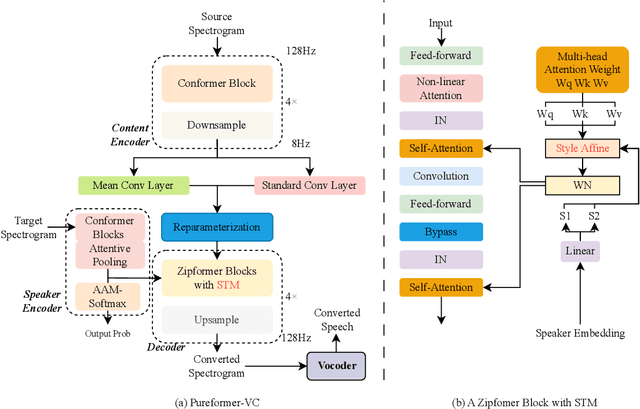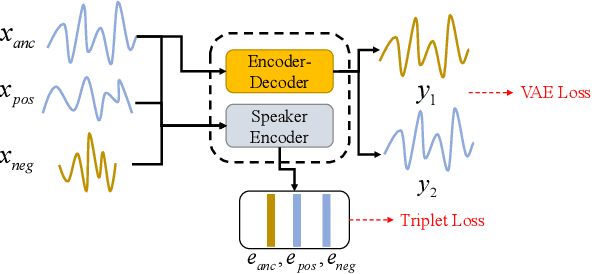Weiping Wen
Pureformer-VC: Non-parallel Voice Conversion with Pure Stylized Transformer Blocks and Triplet Discriminative Training
Jun 10, 2025Abstract:As a foundational technology for intelligent human-computer interaction, voice conversion (VC) seeks to transform speech from any source timbre into any target timbre. Traditional voice conversion methods based on Generative Adversarial Networks (GANs) encounter significant challenges in precisely encoding diverse speech elements and effectively synthesising these elements into natural-sounding converted speech. To overcome these limitations, we introduce Pureformer-VC, an encoder-decoder framework that utilizes Conformer blocks to build a disentangled encoder and employs Zipformer blocks to create a style transfer decoder. We adopt a variational decoupled training approach to isolate speech components using a Variational Autoencoder (VAE), complemented by triplet discriminative training to enhance the speaker's discriminative capabilities. Furthermore, we incorporate the Attention Style Transfer Mechanism (ASTM) with Zipformer's shared weights to improve the style transfer performance in the decoder. We conducted experiments on two multi-speaker datasets. The experimental results demonstrate that the proposed model achieves comparable subjective evaluation scores while significantly enhancing objective metrics compared to existing approaches in many-to-many and many-to-one VC scenarios.
SPBA: Utilizing Speech Large Language Model for Backdoor Attacks on Speech Classification Models
Jun 10, 2025Abstract:Deep speech classification tasks, including keyword spotting and speaker verification, are vital in speech-based human-computer interaction. Recently, the security of these technologies has been revealed to be susceptible to backdoor attacks. Specifically, attackers use noisy disruption triggers and speech element triggers to produce poisoned speech samples that train models to become vulnerable. However, these methods typically create only a limited number of backdoors due to the inherent constraints of the trigger function. In this paper, we propose that speech backdoor attacks can strategically focus on speech elements such as timbre and emotion, leveraging the Speech Large Language Model (SLLM) to generate diverse triggers. Increasing the number of triggers may disproportionately elevate the poisoning rate, resulting in higher attack costs and a lower success rate per trigger. We introduce the Multiple Gradient Descent Algorithm (MGDA) as a mitigation strategy to address this challenge. The proposed attack is called the Speech Prompt Backdoor Attack (SPBA). Building on this foundation, we conducted attack experiments on two speech classification tasks, demonstrating that SPBA shows significant trigger effectiveness and achieves exceptional performance in attack metrics.
EmoAttack: Utilizing Emotional Voice Conversion for Speech Backdoor Attacks on Deep Speech Classification Models
Sep 06, 2024



Abstract:Deep speech classification tasks, mainly including keyword spotting and speaker verification, play a crucial role in speech-based human-computer interaction. Recently, the security of these technologies has been demonstrated to be vulnerable to backdoor attacks. Specifically speaking, speech samples are attacked by noisy disruption and component modification in present triggers. We suggest that speech backdoor attacks can strategically focus on emotion, a higher-level subjective perceptual attribute inherent in speech. Furthermore, we proposed that emotional voice conversion technology can serve as the speech backdoor attack trigger, and the method is called EmoAttack. Based on this, we conducted attack experiments on two speech classification tasks, showcasing that EmoAttack method owns impactful trigger effectiveness and its remarkable attack success rate and accuracy variance. Additionally, the ablation experiments found that speech with intensive emotion is more suitable to be targeted for attacks.
Pureformer-VC: Non-parallel One-Shot Voice Conversion with Pure Transformer Blocks and Triplet Discriminative Training
Sep 03, 2024



Abstract:One-shot voice conversion(VC) aims to change the timbre of any source speech to match that of the unseen target speaker with only one speech sample. Existing style transfer-based VC methods relied on speech representation disentanglement and suffered from accurately and independently encoding each speech component and recomposing back to converted speech effectively. To tackle this, we proposed Pureformer-VC, which utilizes Conformer blocks to build a disentangled encoder, and Zipformer blocks to build a style transfer decoder as the generator. In the decoder, we used effective styleformer blocks to integrate speaker characteristics into the generated speech effectively. The models used the generative VAE loss for encoding components and triplet loss for unsupervised discriminative training. We applied the styleformer method to Zipformer's shared weights for style transfer. The experimental results show that the proposed model achieves comparable subjective scores and exhibits improvements in objective metrics compared to existing methods in a one-shot voice conversion scenario.
Imperceptible Rhythm Backdoor Attacks: Exploring Rhythm Transformation for Embedding Undetectable Vulnerabilities on Speech Recognition
Jun 16, 2024Abstract:Speech recognition is an essential start ring of human-computer interaction, and recently, deep learning models have achieved excellent success in this task. However, when the model training and private data provider are always separated, some security threats that make deep neural networks (DNNs) abnormal deserve to be researched. In recent years, the typical backdoor attacks have been researched in speech recognition systems. The existing backdoor methods are based on data poisoning. The attacker adds some incorporated changes to benign speech spectrograms or changes the speech components, such as pitch and timbre. As a result, the poisoned data can be detected by human hearing or automatic deep algorithms. To improve the stealthiness of data poisoning, we propose a non-neural and fast algorithm called Random Spectrogram Rhythm Transformation (RSRT) in this paper. The algorithm combines four steps to generate stealthy poisoned utterances. From the perspective of rhythm component transformation, our proposed trigger stretches or squeezes the mel spectrograms and recovers them back to signals. The operation keeps timbre and content unchanged for good stealthiness. Our experiments are conducted on two kinds of speech recognition tasks, including testing the stealthiness of poisoned samples by speaker verification and automatic speech recognition. The results show that our method has excellent effectiveness and stealthiness. The rhythm trigger needs a low poisoning rate and gets a very high attack success rate.
Why an Android App is Classified as Malware? Towards Malware Classification Interpretation
Apr 24, 2020



Abstract:Machine learning (ML) based approach is considered as one of the most promising techniques for Android malware detection and has achieved high accuracy by leveraging commonly-used features. In practice, most of the ML classifications only provide a binary label to mobile users and app security analysts. However, stakeholders are more interested in the reason why apps are classified as malicious in both academia and industry. This belongs to the research area of interpretable ML but in a specific research domain (i.e., mobile malware detection). Although several interpretable ML methods have been exhibited to explain the final classification results in many cutting-edge Artificial Intelligent (AI) based research fields, till now, there is no study interpreting why an app is classified as malware or unveiling the domain-specific challenges. In this paper, to fill this gap, we propose a novel and interpretable ML-based approach (named XMal) to classify malware with high accuracy and explain the classification result meanwhile. (1) The first classification phase of XMal hinges multi-layer perceptron (MLP) and attention mechanism, and also pinpoints the key features most related to the classification result. (2) The second interpreting phase aims at automatically producing neural language descriptions to interpret the core malicious behaviors within apps. We evaluate the behavior description results by comparing with the existing interpretable ML-based methods (i.e., Drebin and LIME) to demonstrate the effectiveness of XMal. We find that XMal is able to reveal the malicious behaviors more accurately. Additionally, our experiments show that XMal can also interpret the reason why some samples are misclassified by ML classifiers. Our study peeks into the interpretable ML through the research of Android malware detection and analysis.
 Add to Chrome
Add to Chrome Add to Firefox
Add to Firefox Add to Edge
Add to Edge